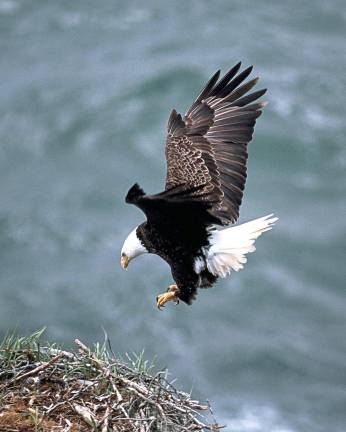Bald eagle’s nest discovered near I-80 expansion project
Stroudsburg. An excavation investigation found it while looking for the original Fort Hamilton site.

Archaeologists conducting an excavation on private property in Stroudsburg have uncovered more than just traces of history. According to a press release from the office of State Rep. Tarah Probst (D- Monroe/Pike), while investigating a possible site of the original Fort Hamilton, a large nest believed to belong to a bald eagle was found high in the trees along the I-80 corridor.
Federal guidelines establish a 660-foot buffer zone around active bald eagle nests, within which construction activity is restricted due to the federally protected species. Early review indicates that this buffer may extend into Stroud Township and overlap with Phase 1 of the Federal Highway Administration and PennDOT I-80 expansion project plans.
The nest discovery was immediately reported to the U.S. Fish & Wildlife Service and the Pennsylvania Natural Heritage Program, which coordinates with the state Department of Conservation and Natural Resources. While there has not yet been a formal response from federal authorities, a state official has confirmed the U.S. Fish & Wildlife Service has been informed of the eagle’s location.
The archaeological team had originally been investigating the true location of Fort Hamilton, a French and Indian War-era fort which was built under the direction of Benjamin Franklin. For decades, it was believed to be located near Main Street and the Monroe County Historical Association. But no artifacts were found during excavations connected with MCHA’s new facility. Instead, a Library of Congress map suggested that the fort’s position may have been closer to the current I-80 corridor, prompting the ongoing excavation, and unexpectedly revealing the eagle’s nest.
The nest discovery is not listed in the Pennsylvania Natural Diversity Inventory associated with the I-80 project, raising questions about the adequacy of the environmental review process.
“Stroudsburg’s natural and historic treasures are part of what make our community so unique,” Probst said. “The discovery of a bald eagle’s nest alongside the potential site of Fort Hamilton underscores the need for responsible stewardship before we make irreversible changes to the landscape, including a full Environmental Independent Study vs. the half-hearted Environmental Assessment. We owe it to both history and future generations to proceed with extreme care.”
“This is an extraordinary find,” said Danny Younger, a local archaeologist involved with the dig. “We set out to learn more about Fort Hamilton, but instead we encountered a living symbol of American freedom. It’s rare that archaeology and wildlife conservation intersect so directly. Both deserve thoughtful protection.”
The implications for the I-80 expansion remain under review, but local conservation advocates stress the importance of protecting both Pennsylvania’s natural heritage and its historic sites.
Probst said anyone with additional concerns about the I-80 project should call her staffer Jessica Smith at (570) 420-2850 or email jsmith@pahouse.net.